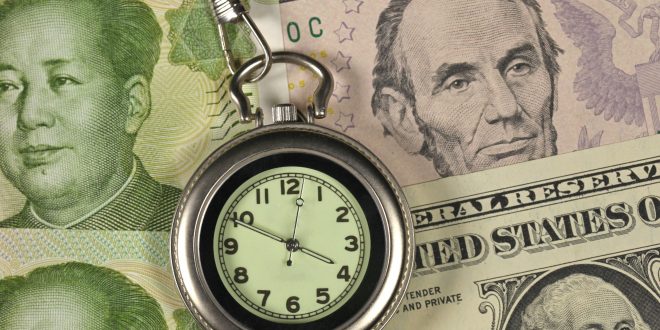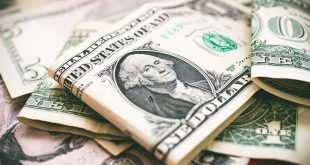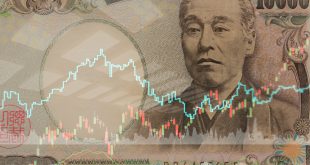The dollar remained close to a peak of more than a week on Friday after a slew of data released overnight indicated a slowdown in the US economy, as investors bet the Federal Reserve would halt interest rate increases.
The dollar index, which measures the performance of the US currency against six major currencies, fell 0.059 percent to 102.02, remaining close to the level of 102.15 it touched overnight, the highest since May 2nd. The index is set to end a two-week losing streak, rising 0.7% this week.
Carol Kong, currency analyst at the Commonwealth Bank of Australia, said weak US economic data may have encouraged the market while still weighing in on the chances of the Fed cutting interest rates sharply this year.
The number of Americans filing new applications for unemployment benefits last week jumped to the highest level in a year and a half, pointing to cracks in the labor market as demand slowed, according to data released on Thursday that also showed a slight rebound in producer prices in April.
The reports came in line with the expectation of most economists of a recession by the end of the year.
Federal Reserve policymakers have about five more weeks of data to analyze before their next meeting, and they said they plan to scrutinize it carefully before making a decision.
Meanwhile, the euro rose 0.03 percent to 1.0917 dollars, and the Japanese yen rose 0.03 percent to 134.53 dollars.
The Australian dollar fell 0.01% to $0.670, while its New Zealand counterpart fell 0.24% to $0.628.
And the pound sterling recorded $ 1.2512 in the latest transactions, up 0.02 percent during the day, after declining 0.6 percent on Thursday.
The Bank of England raised its main interest rate a quarter of a percentage point to 4.5 percent on Thursday, and Governor Andrew Bailey said the Bank of England would “stay on track” as it seeks to rein in inflation, which has been the fastest among major economies.
Gold
Gold turned higher on Friday, after falling earlier in the session, as investors took advantage of falling prices, while demand for the precious metal continued as a safe haven due to economic risks, including fears of a US government debt default.
Spot gold rose 0.1% to $2,018.29 an ounce by 1410 GMT, after falling 0.7% earlier in the session. US gold futures rose 0.2% to $2,023.40.
“Gold saw some stability here this morning, with some buying after the dip,” said Bob Haberkorn, chief market analyst at (RGO Futures).
Gold closed lower in the past two sessions as the rival safe-haven dollar rose to its highest level in a week, making bullion less attractive to buyers holding other currencies.
US Treasury Secretary Janet Yellen said there was still uncertainty about when the government’s debt repayments would run out, possibly as early as June 1.
Gold usually makes gains during times of economic or financial uncertainty.
As for other precious metals, spot silver fell 0.1 percent to $24.14 an ounce, recording the worst week in seven months, with a loss of six percent.
Platinum fell 1.8 percent to $1,074.33. Palladium also fell 1.6 percent to $ 1,526.94, but both are on the way to achieving weekly gains.
Oil
Oil prices fell on Friday, posting a third consecutive weekly loss, as the market balanced concerns about supplies with renewed economic concerns in the United States and China.
Brent crude futures fell 59 cents, or 0.8 percent, to $74.39 a barrel by 1707 GMT. US crude futures fell 55 cents, or 0.8 percent, to $70.32.
The two benchmarks are on their way to incurring a weekly loss of about 1 percent.
The dollar held on to modest gains against the euro on Friday and is on track to record its biggest weekly gain since February as uncertainty about the debt ceiling and monetary policy in the United States turned investors into safe-haven assets.
A stronger dollar makes oil, denominated in the greenback, more expensive for holders of other currencies.
And increased fears of entering the United States, the largest oil consumer in the world, in a state of recession after the delay in the decision to raise the ceiling of the debt of the US government and the growing concern about the failure of another regional bank.
At the same time, Chinese consumer prices rose in April at a slower pace than in March, which was contrary to expectations, while the decline in producer prices revived doubts that the recovery of the Chinese economy after the pandemic will lead to growth in oil demand.
The market drew support from expectations of a supply shortage in the second half of the year, even though Iraqi Oil Minister Hayan Abdul Ghani told Reuters on Friday that he did not expect the OPEC+ alliance to decide on a new production cut at its next meeting in Vienna on June 3-4.
On Thursday, the Organization of the Petroleum Exporting Countries (OPEC) kept its forecast for global oil demand growth in 2023 unchanged, adding that higher demand from China would offset the impact of economic risks.
 Noor Trends News, Technical Analysis, Educational Tools and Recommendations
Noor Trends News, Technical Analysis, Educational Tools and Recommendations





